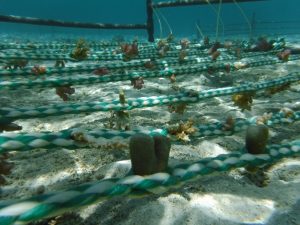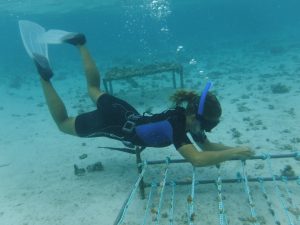One afternoon about five years ago, I was draped on the couch while the Mother City threw a tantrum of rain and wind outside. National Geographic was screening a documentary series by a marine biologist – a woman, fierce and smart and incredible. I’d seen female scientists before, of course, but none with the same kind of chemistry and zeal. Her name was Sylvia Earle, and she is the most inspiring person I’ve ever encountered. I was in awe of this powerful woman undertaking incredible deep-sea explorations; it ignited something in me.
I wasn’t sure if I saw myself as ‘scientist material’, but it felt like a good path anyway. Many would have some kind of opinion about this, or a concern over what job one could get, or whether it’s a useful thing to learn about at all. But none of that seemed important as I stood looking up at the University of Cape Town’s Science Faculty building, about to go into my first chemistry lecture. Five years later, I have absolutely no regrets.
It was a trip to Australia that entrenched my passion for reefs. I did an exchange at the University of Queensland in Brisbane that led to a trip to the Great Barrier Reef and a research project on corals. The university had a research station on Heron Island with tanks of coral used for investigating growth, spawning and resilience. I had never heard of coral cultivation before, so it caught my attention. So much so that I was convinced it would be what I did with my degree. Sure enough, after graduating, I trawled the internet looking for projects I could get involved in.
My family had moved to Mauritius in the South African winter of 2018 and I needed to pay them a visit. I looked for projects in the area and was lucky enough to find an opening for an intern at Lagon Bleu. I was to start in the first week of October 2018.
The project
Lagon Bleu, a division of Mauritian NGO EcoSud, is aimed at preserving the coastal area of Blue Bay and Pointe d’Esny, a small region in the southeast of the island. They do this through a variety of avenues, some of which are hands-on conservation projects such as coral farming. The other research areas involve species-diversity monitoring, turtle monitoring, sensitising and creating awareness (specifically among fishermen and schools), and a marine-guide programme aimed at promoting sustainable tourism.
Blue Bay, where we were based, holds ‘marine park’ status, meaning it is a protected area that allows no fishing in the region, which benefits from a well-controlled tourism industry. Most of our time spent in the park was for turtle monitoring. This activity was quite exhausting as it involved swimming its entire length searching for these shy creatures. Two species are monitored under the project, hawksbill and green turtles. We would spot up to six per swim, photograph and identify them by analysing the photos back at the office. Frequent visitors of the park were Coco, Cookie, Manzana and Lemon.
Pointe d’Esny, however, is probably my favourite corner of Mauritius. It is a quiet spot with no intrusively massive hotels or resorts. The reefs just offshore of its blindingly white beach are probably some of the island’s best. It was from here to the edge of Blue Bay that we monitored the life of the lagoon.
The turtle and lagoon monitoring were an added bonus due to the small size of the NGO and each project’s need for people. The coral farming was the main attraction for me. Corals are incredibly interesting creatures. The simplest way to describe them is as a family of small, fleshy polyps sharing one gigantic calcium-carbonate home. They survive due to their symbiotic relationship with zooxanthellae, the microscopic algae living in the coral polyps that photosynthesize carbohydrates for them to ‘eat’. In return, the zoos get carbon dioxide (imperative for algae to grow) and a safe place to live. The zoos are what give corals their colour, so when a coral is bleached it is because zoos have left the polyps due to stress.
Coral farming is an increasingly important strategy for replenishing reefs lost due to climate change and human impact. Most coral-farming projects today are used as research platforms to test ecological resilience, i.e. the buffering capacity of a system. The farming helps us determine how to make these fundamental creatures survive the changing world. The farms we built at Lagon Bleu are not purely for research purposes, but also to repopulate some of the dead or dying reefs in Mauritius and see what can grow best in its waters.

Newly planted coral fragments.
The method
When I arrived, the project had only been running for about a year. Instead of land-based nurseries, which were the only kind I was familiar with, Lagon Bleu had set up some structures in the ocean just north of Ile aux Aigrettes in a sandy patch with fast-flowing waters. Farms designed to host a very specific coral called Porites (a bulbous massive-growing structure that looks like a boulder) were first put in the water in October 2017. In May 2018, another structure was placed in the water designed to grow branching corals such as Acropora.
The team had a new design for the farms that would make them easier to manage and less susceptible to boat damage – next up was actually building them. My partner, Isabel, and I were handed a scruffy piece of paper with a rough drawing of some square-looking object, a few measurements and told to build eight. Two blonde girls, fighting the stereotypes, covered in cement, PVC glue and plastic shavings. Our hands were blistered and broken from cutting plastic pipes with a rusty old saw, and we’d used an angle grinder to cut metal stakes wearing some sunglasses. I mean, it’s an island. A couple of afternoons later we had two wonky and six not-as-wonky frames that were to hold our corals.
It was recently discovered that when a piece of coral breaks off from its main colony, it grows much faster than the colony itself. This was a remarkable finding, as it means scientists can grow them 25 to 50 times faster than a colony would in nature. Naturally, the smaller you break the coral down, the more individual pieces you have growing at a faster rate. Thus, the most efficient method would be micro-fragmenting the corals with a specialised saw into pieces as tiny as one individual polyp. Clone fragments recognise each other, so instead of fighting for resources as corals do in nature, they will fuse. This is incredible as you can grow a piece of coral that would usually take a hundred years in just two. Furthermore, the recombined colonies become sexually mature faster, which can take up to 75 years in nature.
The method we used at Lagon Bleu was a lot simpler to execute than micro-fragmenting and didn’t require any high-tech lab equipment. First, we would go out on the boat to a healthy part of the reef to collect larger colonies of coral. Since this was still a pilot project, we wanted to test a few that were already known to grow well under these conditions. Some of my favourites were the Pocillopora damicornis, Galaxea fascicularis and Acropora loripes. Once at the site, we could start breaking the colonies down to smaller pieces a couple of centimetres long. The pieces were inserted into a length of rope that was then tied onto the frame, which had already been placed in the water.

Isabel attaching ropes full of coral to one of the structures.
Maintaining these farms and keeping the corals alive is the real challenge. Algae can take over in a few days, so brushing the frames and pieces is important to keep the coral healthy. There are many challenges with having farms in the ocean, primarily the lack of control you have over water quality and temperature. Corals can be very sensitive, especially when it comes to water temperatures. Considering the climatic changes our world is going through, growing corals in sub-optimum conditions is risky. But, they have the capacity to adjust. There has been some evidence that certain corals are becoming more resilient to temperature change, just not at a rate that can keep up with the changing climate.
In conclusion
Ultimately, what this experience taught me was that we have the knowledge and ability to actively restore the damage that has been caused. There are many projects and organisations working to maximize on the knowledge gained. A healthy ocean is a healthy planet, and the state it is in currently is not sustainable on any level. Coral Vita is the another perfect example of youth taking back their future. Their team is made up of young graduates who have established a network of global land-based farms to grow corals that can survive in changing ocean conditions. You can even adopt a coral fragment on their website. This, I believe, is the kind of work that will carry us into the future.
By Sam Hale


